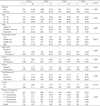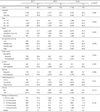Abstract
Purpose
The purpose of this study is to analyze nutrient intake and frequently consumed foods according to the intake frequency of Baechu (Chinese cabbage) kimchi by Korean adults.
Methods
Data from analysis of 7,122 subjects aged 19~64 years from 2012, 2013 KNHANES were obtained from health behavior interviews and the 24-hour dietary recall method.
Results
With the daily intake frequency of Baechu kimchi, subjects with two times a day were the highest proportion among total subjects. As Baechu kimchi intake frequency of breakfast, lunch, and dinner increased, the rate of skipping meals decreased significantly (p < 0.05). In addition, all food intake and daily nutrient intake increased significantly with increasing frequency of daily Baechu kimchi intake (Crude p for trend < 0.05, Adjusted p for trend < 0.05). With the frequently consumed foods by daily Baechu kimchi intake frequency in 2012 and 2013, among 509 foods top ranked foods were white rice, Baechu kimchi, beer, distilled alcoholic drink, milk, and pork.
Figures and Tables
Table 4
Comparison of general characteristics and dietary pattern according to intake frequency of Baechu kimchi

References
1. Yang YJ, Ahn IS, Han JS. Anti-obesity effect and fermentation characteristics of American preferred kimchi added to garcinia cambogia extracts (hydroxy citric acid). J Korean Soc Food Sci Nutr. 2005; 34(6):776–783.
2. Kong YH, Cheigh HS, Song YO, Jo YO, Choi SY. Anti-obesity effects of kimchi tablet composition in rats fed high-fat diet. J Korean Soc Food Sci Nutr. 2007; 36(12):1529–1536.

3. Kim HY, Noh JS, Song YO. Inhibition effect of 3-(4'-hydroxyl-3',5'-dimethoxyphenyl) propionic acid in kimchi with anti-atherogenic activity on the accumulation of lipids in the organs of ApoE(-/-) mice. J Korean Soc Food Sci Nutr. 2008; 37(11):1415–1421.
4. Mo EK, Kim SM, Yang SA, Jegal SA, Choi YS, Ly SY, Sung CK. Properties of baechu kimchi treated with black rice water extract. Korean J Food Preserv. 2010; 17(1):50–57.
5. Yang YR, Kim HL, Park YK. Effects of onion kimchi extract supplementation on blood glucose and serum lipid contents in streptozotocin-induced diabetic rats. J Korean Soc Food Sci Nutr. 2008; 37(4):445–451.

6. Lee SY, Song YO, Han ES, Han JS. Comparative study on dietary habits, food intakes, and serum lipid levels according to kimchi consumption in college students. J Korean Soc Food Sci Nutr. 2012; 41(3):351–361.

7. Chang SK, Kim HJ. Physico-chemical properties and in vivo anticancer effects of potato kimchi prepared by adding hot water extracts of potato. J East Asian Soc Diet Life. 2008; 18(3):302–310.
8. Han GJ, Son AR, Lee SM, Jung JK, Kim SH, Park KY. Improved quality and increased in vitro anticancer effect of kimchi by using natural sea salt without bittern and baked (Guwun) salt. J Korean Soc Food Sci Nutr. 2009; 38(8):996–1002.

9. Lee IH, Lee SH, Lee IS, Park YK, Chung DK, Choue R. Effects of probiotic extracts of kimchi on immune function in NC/Nga mice. Korean J Food Sci Technol. 2008; 40(1):82–87.
10. Jeong SH, Lee HJ, Jung JY, Lee SH, Seo HY, Park WS, Jeon CO. Effects of red pepper powder on microbial communities and metabolites during kimchi fermentation. Int J Food Microbiol. 2013; 160(3):252–259.

11. Jang MS, Seo KC, Nam KH, Park HY. Fermentation characteristics of cuttlefish kimchi with yogurt and vitamin C. Korean J Food Preserv. 2012; 19(5):774–782.

12. Lim JH, Park SS, Jeong JW, Park KJ, Seo KH, Sung JM. Quality characteristics of kimchi fermented with abalone or sea tangle extracts. J Korean Soc Food Sci Nutr. 2013; 42(3):450–456.

13. Seo HS, Kim SH, Kim JS, Han JJ, Ryu JH. Control of kimchi fermentation by the addition of natural antimicrobial agents originated from plants. Korean J Food Sci Technol. 2013; 45(5):583–589.

14. Chang JY, Kim IC, Chang HC. Effect of solar salt on kimchi fermentation during long-term storage. Korean J Food Sci Technol. 2014; 46(4):456–464.

15. Park JE, Lee JY, Jang MS. Quality characteristics of Yulmoo Mulkimchi containing saltwort (Salicornia herbacea L.). J Korean Soc Food Sci Nutr. 2011; 40(7):1006–1016.

16. Hahn YS, Oh JY, Kim YJ. Characteristics of low-salt kimchi prepared with salt replacement during fermentation. Korean J Food Sci Technol. 2002; 34(4):647–651.
17. Lee YS, Rho JO. Quality characteristics of kimchi with added Backryeoncho (Opuntia ficus-indica var. saboten) extract and its acceptability by middle school students. Korean J Hum Ecol. 2012; 21(6):1211–1222.

18. Lee YS, Rho JO. Quality characteristics of kimchi with mulberry leaves enzyme liquid and its acceptability by middle school students. Korean J Hum Ecol. 2014; 23(3):467–481.

19. You BR, Kim HJ. Quality characteristics of kimchi added with allium hookeri root. J Korean Soc Food Sci Nutr. 2013; 42(10):1649–1655.

20. Hwang IG, Kim HY, Hwang Y, Jeong HS, Lee JS, Kim HY, Yoo SM. Changes in quality characteristics of kimchi added with the fresh red pepper (Capsicum Annuum L.). Korean J Food Cook Sci. 2012; 28(2):167–174.

21. Kim SH, Kim MJ, Kim HJ, Song YO. Development and evaluation of kimchi menus for elementary school food service. J Korean Soc Food Sci Nutr. 2013; 42(7):1148–1156.

22. Min SH. Perceptions and acceptances related to kimchi among elementary school students in Jecheon area. J East Asian Soc Diet Life. 2014; 24(5):564–571.

23. Song DY, Park JE, Shim JE, Lee JE. Trends in the major dish groups and food groups contributing to sodium intake in the Korea National Health and Nutrition Examination Survey 1998-2010. Korean J Nutr. 2013; 46(1):72–85.

24. Ministry of Health and Welfare, Korea Centers for Disease Control and Prevention. Korea Health Statistics 2012: Korea National Health and Nutrition Examination Survey (KNHANES V-III). Cheongwon: Korea Centers for Disease Control and Prevention;2013.
25. Kwon Y. Association of curry consumption with blood lipids and glucose levels. Nutr Res Pract. 2016; 10:212–220.

26. Lee Y, Shim JE, Yoon J. Change of children's meal structure in terms of temporal and spatial dimensions: analysis of the data from the Korea National Health and Nutrition Examination Surveys of 1998 and 2009. Korean J Community Nutr. 2012; 17(1):109–118.
27. Kwon YS, Ju SY. Trends in nutrient intakes and consumption while eating-out among Korean adults based on Korea National Health and Nutrition Examination Survey (1998-2012) data. Nutr Res Pract. 2014; 8(6):670–678.

28. Chung SJ, Kang SH, Song SM, Ryu SH, Yoon J. Nutritional quality of Korean adults' consumption of lunch prepared at home, commercial places, and institutions: analysis of the data from the 2001 National Health and Nutrition Survey. Korean J Nutr. 2006; 39(8):841–849.
29. Kwon YS, Park YH, Choe JS, Yang YK. Investigation of variations in energy, macronutrients and sodium intake based on the places meals are provided: using the Korea National Health and Nutrition Examination Survey (KNHANES, 1998-2009). Nutr Res Pract. 2014; 8(1):81–93.

30. Kim EK, Park YK, Ju SY, Choi EO. A study on the kimchi consumption of Korean adults: using Korea National Health and Nutrition Examination Survey (2010~2012). Korean J Food Cult. 2015; 30(4):406–412.
31. Park KY. The nutritional evaluation, and antimutagenic and anticancer effects of kimchi. J Korean Soc Food Nutr. 1995; 24(1):169–182.
32. Islam MS, Choi H. Antidiabetic effect of Korean traditional Baechu (Chinese cabbage) kimchi in a type 2 diabetes model of rats. J Med Food. 2009; 12(2):292–297.
33. Kim HJ, Lee JS, Chung HY, Song SH, Suh H, Noh JS, Song YO. 3-(4'-hydroxyl-3',5'-dimethoxyphenyl)propionic acid, an active principle of kimchi, inhibits development of atherosclerosis in rabbits. J Agric Food Chem. 2007; 55(25):10486–10492.

34. Kim EK, An SY, Lee MS, Kim TH, Lee HK, Hwang WS, Choe SJ, Kim TY, Han SJ, Kim HJ, Kim DJ, Lee KW. Fermented kimchi reduces body weight and improves metabolic parameters in overweight and obese patients. Nutr Res. 2011; 31(6):436–443.

35. Lee KW, Song WO, Cho MS. Dietary quality differs by consumption of meals prepared at home vs. outside in Korean adults. Nutr Res Pract. 2015; 9:e80.

36. Chung HK. Hansik. Seoul: itreebook;2009.




 PDF
PDF ePub
ePub Citation
Citation Print
Print







 XML Download
XML Download